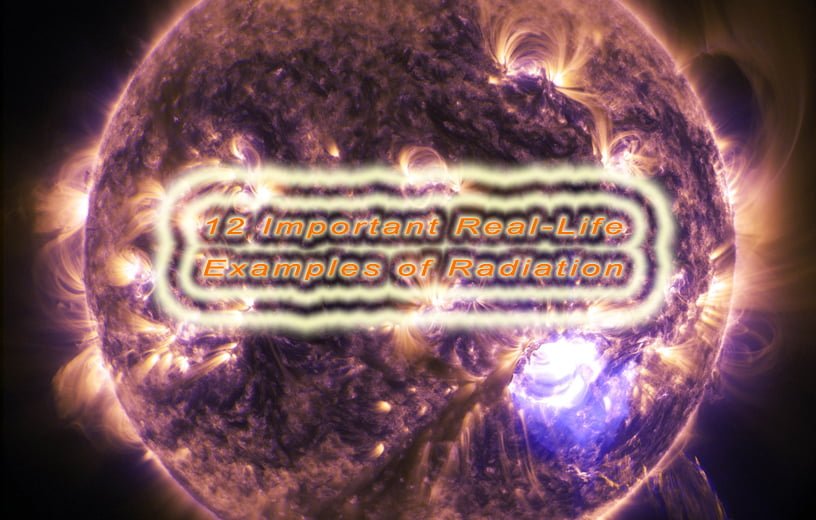- Water Testing Meters
- Anemometer
- Length & Distance Meter
- Multimeter & Clamp Meter
- Light and Sound Meter
- Slide Calipers & Screw Gauge
- Thermometer & Hygrometer
- Milk Testing Meters
- Paper, Grain & Wood Testers
- Stopwatch & Timers
- Soil Testing Meters
- Refractometers & Analyzer
- Magnetic Compass
- Tachometer & Megger
- Thickness & Dia-Meters
- Other Meter And Accessories
12 Important Real-Life Examples of Radiation

In this article, we’re going to take a closer look at the important Real-Life Examples of Radiation.

What is Radiation?
Radiation is the emission and propagation of energy. It is not necessary, however, that radiation will be emitted only by radioactive materials. Radiation includes all forms of energy. It has been a part of the environment since time immemorial. No matter what we do or where we go, we cannot escape this form of energy. We are surrounded by many radioactive materials like floors, walls, and ceilings in our homes and offices. Also, the food we eat contains radioactive material. Not only that, but the air around us also contains radioactive gases. You may find it quite surprising but our own bodies contain many natural radioactive elements.
Let’s go to see some real-life examples of radiation:
- Ultraviolet Light From the Sun
- The Heat From a Stove Burner
- X-rays from an X-ray Machine
- Alpha particles emitted from the Radioactive Decay of Uranium
- Sound waves from your stereo
- Microwaves from a Microwave Oven
- Electromagnetic Radiation from Your Cell Phone
- Ultraviolet Light from a Black Light
- Radiation from Television
- Microwave Radiation from Your Wifi Router
- A Laser Beam
- Gamma Radiation from a Supernova
(1) Ultraviolet Light From the Sun
One of the main sources of energy is the sun. Cosmic radiation emitted from the Sun is a mixture of electromagnetic waves; which range from infrared (IR) to ultraviolet (UV). Also, it emits visible light. Most of the radiation emitted by the sun is absorbed by the atmosphere. But the part that is not absorbed by the atmosphere reaches the Earth. Humans are exposed to this portion of radiation almost all the time.
(2) Heat From a Stove Burner
While boiling water or cooking food, we are again exposed to radiation. The visible sign of radiation is when you heat a substance as hot as possible, for example, heating a stove for a long time will cause it to turn red. This is a visible sign of radiation. However, even if it is not visibly glowing, it still radiates heat. Furthermore, if the bottom of the stove and pan are not in physical contact, radiation is responsible for transferring heat from the stove to the pan.
(3) X-rays from an X-ray Machine
There is no doubt that during medical imaging, a person is exposed to high levels of radiation. During X-ray, CT, and nuclear imaging, the body’s internal organs, and structures are exposed by penetrating high-energy wavelengths or particles.
(4) Alpha Particles Emitted from the Radioactive Decay of Uranium
A classic example of radiation is alpha particles emitted from the radioactive decay of uranium. Energy is continuously emitted from the radioactive decay of uranium.
(5) Sound Waves from Your Stereo
Radio waves are most commonly used in communication. Televisions, cell phones, and radios use radio waves and, in turn, convert them into vibrations to create sound waves. Artificial sources of radio waves include electrical generators, power lines, appliances, and radio transmitters.
(6) Microwaves from a Microwave Oven
Microwave ovens use high levels of radiation to heat food. Food is heated in a microwave oven when the microwave is absorbed by the water content present in the food. The absorption of microwaves causes water molecules to vibrate and therefore generate heat.
(7) Electromagnetic Radiation from Your Cell Phone
It may not come as a surprise to you that mobile phones emit non-ionizing radiation from their antennas. Exposure to radiofrequency radiation heats the area of the body where a mobile phone is held to the ear. But the amount of heat radiated is not enough to raise the body temperature.
(8) Ultraviolet Light from a Black Light
Large amounts of ultraviolet radiation are produced by tanning booths, black lights, mercury vapor lamps, halogen lights, fluorescent and incandescent sources, and some types of lasers, which are artificial sources of radiation. Black lights, also known as ultraviolet lamps, emit ultraviolet radiation that is visible to the human eye as black light.
(9) Radiation from Television
Television has formed one of the most common forms of entertainment in the last few years. Televisions also emit radiation. Old television sets emit X-ray waves that can be easily absorbed by the human body and are also harmful. However, modern TV sets use liquid crystal displays (LCD) or plasma displays that are not only less harmful than older sets but also incapable of producing X-rays. However, modern technological devices emit radio waves.
(10) Microwave Radiation from Your Wifi Router
With the advancement of technology, WiFi routers have found their way into every home. There is no denying that WiFi has become an important part of our daily lives. However, you may be surprised to know that WiFi routers also emit electromagnetic radiation. Exposure to such electromagnetic radiation can also affect human health.
(11) A Laser Beam | Examples of Radiation
As the name suggests, light amplification also produces stimulated emission radiation. Laser exposure often causes temporary blindness, confusion, and headaches. However, lasers have found widespread use in lithography, printing, optics, DNA sequencing, medicine and surgery, and laser cutting.
(12) Gamma Radiation from a Supernova
Gamma rays from supernovae are a classic example. Gamma rays are constantly being emitted from supernovae. Astronomers detect a GRB only when one of these jets points almost directly at Earth. Each jet drills through the star, producing a pulse of gamma rays — the highest-energy form of light — that can last for several minutes. After the explosion, the disrupted star expands rapidly as a supernova.
Recommendation:
Labtex is a seller and supplier of electromagnetic radiation meters in Bangladesh. If you want to buy a magnetic radiation meter, click here.

